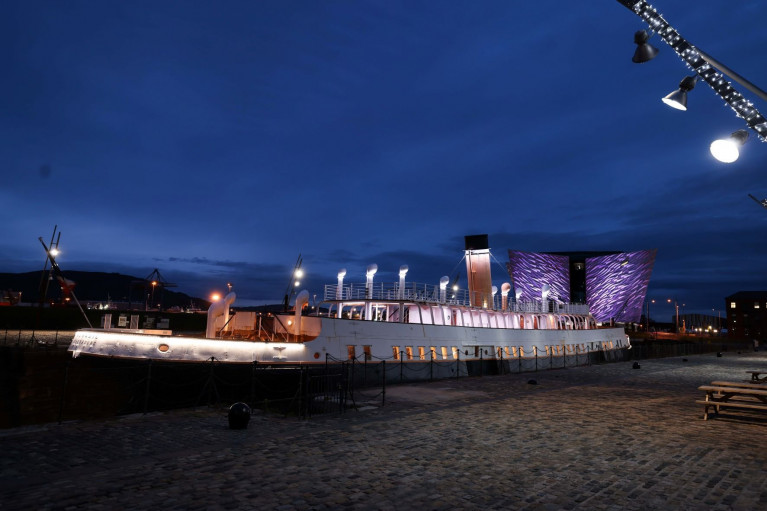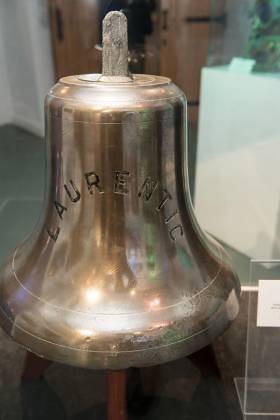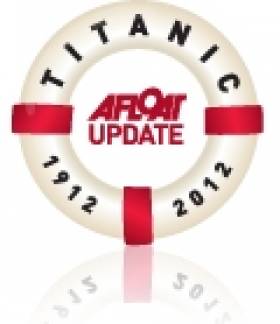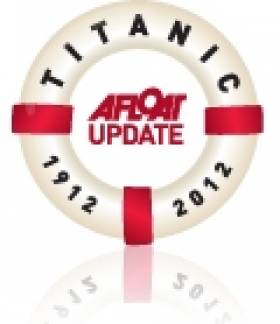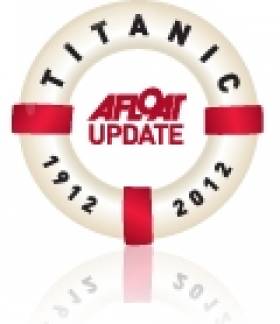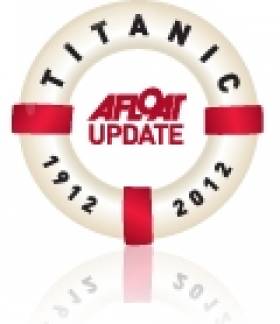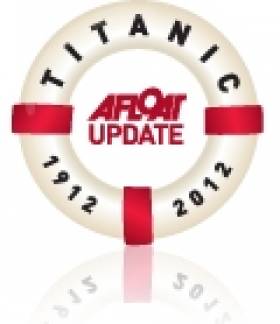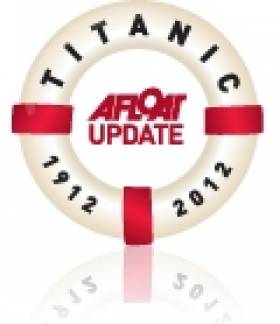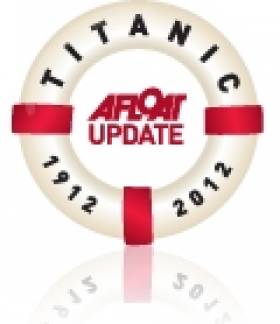Displaying items by tag: White Star Line
New Feature Sees Lights Shine on SS Nomadic's History
A new outdoor lighting feature has been installed on the historic SS Nomadic, providing a new lease of life on the decks of the liner-tender on view at Titanic Belfast.
The project was launched as part of Local History Month celebrations, shining a spotlight on the iconic SS Nomadic which is the last remaining White Star Line vessel.
The £91k investment came from a collaborative partnership by Tourism Northern Ireland and owners of the vessel, Maritime Belfast Trust. The project was undertaken by Anthony Hayes of AH Design, a company with over 30 years’ experience in building services specialising in lighting design.
The completed installation uses accent lighting to elegantly illuminate the ships decks, funnels and gangways. The lights are versatile and can be changed in colour.
These will be co-ordinated with Titanic Belfast’s pre-existing illumination schedule, marking important calendar dates and key local, national and international events.
For further reading from Maritime Belfast in addition to a link on the history of the SS Nomadic.
White Star Line's S.S. Laurentic Bell Makes Homecoming Voyage to Derry
#HistoricBoats - The bell of S.S. Laurentic, one of the most significant artefacts in local maritime history, will make its return to the Derry this week, following purchase at auction by Derry City and Strabane District Council.
The Bell, which was desperately rung by crew as the immense former White Star liner sank in the Lough Swilly, Co. Donegal over a century ago, will go on display at the Guildhall from today, Friday 12 January, before it finds a permanent home as Afloat previously reported in a planned Maritime Museum due to open in 2020 at Ebrington Square.
Curator with Council’s Museums and Visitor Services, Roisin Doherty said she looked forward to seeing the Bell making its return. “We are delighted to display the Laurentic bell once again, particularly in the Guildhall, where the survivors of the wreck were treated to a meal by the Mayor of the city in 1917. The tragic story of the sinking of the vessel is inextricably linked with the city and this is a fantastic way to ensure the legacy of the ship survives in memory.”
The display will be accompanied by an exhibition entitled ‘Letters from The Laurentic’, which chronicles the story of the Laurentic disaster through deeply personal correspondence, through letters, postcards and photographs of the men lost and those, fewer in number, who survived. A short documentary, ‘Wine Dark Sea; Letters from The Laurentic’, will also feature.
The exhibition was commissioned by the Ulster Canada Initiative and produced by Harry Kerr, Martha McCulloch, Jim Doherty and Don McNeill.
The Laurentic Bell is made from bell alloy and is from the Bridge area of the ship. It was found in 1979 by local diver Ray Cossum and his son Des with Allerton Salvage. It weighs 37kg and is 2ft high by 2ft wide at the base. It is one of only two bells from the ship, the other being the bow bell, which is permanently located in the belfry of the Church of Ireland at Portsalon, after being donated by the leader of the original Royal Navy salvage expedition in 1924.
In addition to being a highly important historic artefact recovered from the wreck, the bell is also significant because of a series of dents on its rim. These dents were created by a sailor on the bridge, who on the orders of the captain, beat the bell with a wrench to sound the alarm to abandon ship. The survivors of the wreck were afterwards acknowledged by the then Mayor of Londonderry, Alderman R.N. Anderson, and were beneficiaries of a large scale city-wide relief effort and treated to a meal in the Guildhall.
As referred above the bell exhibition will be on display in the Guildhall from today and continue to Wednesday, 24 January.
Maritime Institute to Host Tributes to Titanic
#TITANIC 100 – In this centenary week of the sinking of RMS Titanic a talk and musical tribute will be held in memory of the disaster this evening (8 pm) in the newly opened maritime museum in Dun Laoghaire as previously reported on Afloat.ie.
Deep-sea diver Rory Golden became the first Irishman to see the wreck of the Titanic and he will present an illustrated lecture. The musical tribute will be led by uillinn piper Eamon Galdubh – where similar music will be aired to that played in the 2nd and 3rd class compartments on the Titanic.
In addition the Maritime Institute of Ireland (M.I.I.) which runs the museum will run its final lecture for the season next week. The lecture 'Titanic -Locked in History' which will be held next Thursday (19th April) at 8pm in the Stella Maris Seafarers Club in Dublin city-centre and is to be presented by Michael O'Flaherty.
For information on both the Titanic Tribute evening (tickets cost €10) call 087 900 7466 and by also viewing the website which includes details about next week's admission free lecture visit: www.mariner.ie
Royal Navy Attend Presidential Fleet Review for Cobh Titanic 100
#COBH TITANIC 100 - Following President Michael D. Higgins visit to Cobh to commemorate the centenary call of RMS Titanic to Queenstown, the town yesterday hosted a Naval Service review that included the Royal Navy's HMS Mersey.
The President as supreme commander of the Defence Forces boarded the Naval Service 'flagship' L.E. Eithne which passed the guest-ship, a River class patrol vessel which headed a line of vessels which lay at anchor of Cobh's waterfront, they were the L.E. Aoife, L.E. Aisling and L.E. Niamh
The historic event which marked the pinnacle of the Titanic 100 Cobh centenary week will continue as part of a year-round programme of events. For information visit www.titanic100.ie. On the homepage the L.E. Niamh features again, where on this occasion marine photographer Jehan Ashmore captured the vessel underway as she powered her way at high-speed through a misty Dalkey Sound.
Among the many places throughout Cobh where thousands of tourists have flocked since the Balmoral docked on Monday to retrace the liner's maiden voyage, has been the White Star Line pier.
From this pier were the last passengers to depart Queenstown on board the tenders PS Ireland and PS America to the ill-fated Titanic that struck an ice-berg. On her Irish call 123 passengers were transferred to the Titanic which lay outside Cork Harbour, while 7 passengers disembarked from the liner and headed ashore.
What remains of the pier which is not accessible to the public and is in danger of collapsing, there has been calls to raise funds to save the structure, as previously reported.
Also in attendance during yesterday's historic proceedings, was the excursion passenger tender Spirit if the Isles which is operating on her second season since starting Cork Harbour cruises last year. They run between Cork city quays and downriver along the Lee to Cobh.
In the 1980's the tender then named Ingot ran excursions from Dun Laoghaire Harbour into Dublin Bay and likewise of L.E. Niamh, she too transited Dalkey Sound as part of her sightseeing tours.
- RMS Titanic
- White Star Line
- Cobh Cruise Callers
- Cobh, Cork Harbour
- Cruiseships
- Balmoral
- FredOlsen Cruise Lines
- Titanic Memorial Cruise
- naval service
- LEEithne
- Royal Navy
- HMS Mersey
- President Michael D Higgins
- Queenstown,Ireland
- PS Ireland
- PS America
- Spirit of the Isles
- Cork Harbour Cruises
- Cork Harbour News
- Dalkey Sound
- LE Niamh
- LE Aoife
- LE Aisling
- Cork Harbour
- River Class Patrol vessels
- River Lee
- Irish marine photographers
President Visits Cobh Commemoration of Titanic 100
#COBH TITANIC 100 – President Michael D Higgins attended a ceremony in Cobh, Co Cork this afternoon to mark the 100th anniversary of Titanic's maiden voyage.
The liner's last port of call was to Cobh (then Queenstown) and was where the last passengers boarded the White Star Line's liner.
The tribute, part of Cobh's Titanic 100 programme of commemorative events, saw a naval fleet review and a flyover from the Irish Air Corps. For more the Irish Examiner has a report.
Titanic Memorial Cruise Heads for Cobh
#TITANIC MEMORIAL CRUISE - Following Balmoral's recent call to Belfast in memory of Titanic, the Fred.Olsen Lines cruiseship returned to Southampton where today she started a 12-night Titanic Memorial Cruise which will follow the White Star Line liner's original itinerary that included calling to Queenstown, now Cobh.
Before Balmoral calls to Cobh tomorrow, she is to pass Cherbourg, where the passenger tender SS Nomadic served the liner that layed anchored offshore. The 101 year-old tender was also built by Harlalnd & Wolff and she is undergoing restoration work in Belfast, to read more about her click HERE.
Likewise to Balmoral's Belfast visit, her arrival to Cobh is the inaugural call for this year's season, though her poignant arrival will be two days short of Titanic's call a century ago on 11th April 1912.
On Titanic's second anchorage at Queenstown, this too required tenders to transfer 123 passengers who embarked from the town's pier and of those only 44 survived the disaster. The timber built pier still exists albeit what survives is in a derelict state. There have been calls to raise funds to save the structure as previously reported.
Along the scenic waterfront passengers can take a tour of the town's new Titanic Experience in the White Star Line building, the Queenstown Heritage Story in the Cobh Hertiage Centre and the walking Titanic Trails.
From Cobh the Balmoral will sail across the Atlantic, arriving at the Titanic site on April 14th/15th - exactly 100 years on from this tragic voyage, where a memorial service will be held to pay tribute to the brave passengers and crew who perished on that fateful night.
The cruise will then continue to Halifax, Nova Scotia, the final resting place of many who were on board, before sailing on to New York, the Titanic's ultimate planned destination.
- White Star Line
- RMS Titanic
- Balmoral
- Fred Olsen Cruise Lines
- Titanic Memorial Cruise
- Cobh Cruise Calls 2012
- Belfast Port
- SS Nomadic
- Titanic's passenger tender
- Cruise ship news
- Cruiseships
- port of Cork
- Cobh Cruise Terminal
- Titanic Trails
- Cobh Heritage Centre
- White Star Line liners
- Queenstown,Ireland
- Harland & Wolff
- Nomadic Charitble Trust
Tours of Titanic’s Tender SS Nomadic
#TITANIC'S TENDER - While all the attention is focused on the R.M.S. Titanic and the newly opened Titanic Belfast visitor experience, the White Star Line passenger tender SS Nomadic is only a stone's throw away from the venue, writes Jehan Ashmore.
Like the liner she was built by Harland & Wolff and her launch took place in 1911. She was commissioned by White Star Line as a 1st and 2nd class passenger tender for Titanic and sister Olympic.
The Nomadic carried out her duties based in Cherbourg, where she transferred passengers to the Titanic on her only call to the Normandy port. As such the vessel which is registered in the French port, is the last surviving White Star Line vessel in the world and the only remaining authentic link to the ill-fated liner.
Decades later, the Nomadic became a floating restaurant on the River Seine in Paris close to the Eiffel Tower, where the venture which started in 1977 remained formore than twenty years.
The ageing vessel faced new safety regulations threatening her fate which ultimately led to her being seized in 2002. She was then offered for sale and then followed a court action for her to be scrapped but a campaign was raised to save the historic vessel which succeeded in her securement.
At 95 years old she was towed by barge back to her builder's birthplace in Belfast in 2006. Now that she is over a century old the vessel is currently undergoing restoration by the SS Nomadic Charitable Trust. She is dry-docked in the Hamilton Dock which adjoins the new iconic landmark of the Titanic Belfast building within the developing Titanic Quarter.
Yesterday 'hard-hat' tours began of the preserved liner tender and it is essential to note that tickets are to be 'pre-booked' with the last tour on 15th April. Daily tours are at 10.30, 12 noon, 2pm and the last tour is 3.30pm. To ensure availability visit: www.nomadicbelfast.com/book-a-tour
For further information about the various visitor attractions and events click the following headings, to be directed to the relevant websites.
The history of the S.S. Nomadic
Titanic Belfast Festival (31 March -22 April)
Titanic Belfast Visitor Experience
Following yesterday's inaugural cruise call to Belfast this year of Balmoral as previously reported the Fred. Olsen Cruise Lines vessel was making a cruise in memory of the liner. To see the list of the other cruiseships calling to the city, click HERE.
- RMS Titanic
- SS Nomadic
- White Star Line
- Nomadic Charitble Trust
- Harland & Wolff
- H&W
- Cherbourg
- White Star Line passenger tenders
- Hamilton Dock, Belfast
- Port of Belfast
- Belfast Lough News
- Cruise ships
- Cruise Liners
- Balmoral
- Fred. Olsen Cruise Lines
- Restaurant river Seine boats
- Titanic Belfast
- Titanic Quater
- Titanic Belfast Festival
- RMS Olympic
Easter Cruisecall to Belfast in Memory of Titanic
#TITANIC – The cruiseship Balmoral not only is the first caller to Belfast for 2012 as previously reported, but her arrival this morning marked more importantly as a cruise in the memory of the R.M.S. Titanic, writes Jehan Ashmore.
Cruise passengers embarked on the Fred. Olsen Cruise Lines ship last Tuesday in Southampton for a mini-cruise which included a call to Liverpool yesterday.
Today passengers where to visit the builders of the White Star Line liner launched a century ago at Harland & Wolff shipyard at Queens Island on the banks of the Lagan.
Adjoining the complex is the Titanic Quarter where the recently opened Titanic Belfast Visitor Experience is making an impression through the iconic landmark, for further details click HERE.
Lecture ‘Fr Brown: From Titanic to Kangaroobie’
#LECTURE – The Old Dublin Society and the RDS are joint organisers of the lecture 'Fr Brown: From Titanic to Kangaroobie' which is to be held at the Ballsbridge venue in Dublin next Wednesday (11th April).
David Davison will be the guest speaker for the lecture that starts at 6pm in the Minerva Suite. Those intending to visit should book by calling (01) 2407 254 or email: [email protected]
The Old Dublin Society which hosts a winter and spring lecture programme is normally hosted in the Dublin City Library and Archive on Pearse Street.
For further information on all lectures visit: www.olddublinsociety.ie
Lecture: R.M.S. Titanic-The True Story
#LECTURES- The Old Dublin Society is to host a lecture 'R.M.S. Titanic – The True Story' which is to be presented by Ed Coghlan next Wednesday (14th March) in Dublin City Library on Pearse Street.
The lecture starts at 6.30pm and will be held in the libraries Archive Conference Room. All are welcome to attend the lecture which is admission free. For further information about the society visit www.olddublinsociety.ie/ in addition the library by clicking HERE.


























